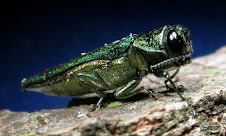Friday, May 28, 2010
Invasive Species
I have two invasive species to show you today.
Sparrow: First off is the sparrow it's very invavsive to prairies all aorund. The color of it is brown and gray. The male has a darker chest than the female to distinct themselves. They can grow up 6.5 inches but usually only 5.5 inches. The latin of the sparrow is Grogaies. It's called that because of it's loud mating call in the spring.
The ash bore:
The ash bore can fly a short distance and spreads due to people transporting its larvae burrowed under ash bark.It was accidentally brought to the USA from asia in the 1990's. They cut off the channels that carry nutrients, water and sugar to nourish the tree.
Sparrow: First off is the sparrow it's very invavsive to prairies all aorund. The color of it is brown and gray. The male has a darker chest than the female to distinct themselves. They can grow up 6.5 inches but usually only 5.5 inches. The latin of the sparrow is Grogaies. It's called that because of it's loud mating call in the spring.
The ash bore:
The ash bore can fly a short distance and spreads due to people transporting its larvae burrowed under ash bark.It was accidentally brought to the USA from asia in the 1990's. They cut off the channels that carry nutrients, water and sugar to nourish the tree.
Invasive Plants
The thisile is a common name of a group of plants. The thistles have leaves with sharp prickles. Thistles are normally located in croplands, pastures, rangelands and other land.
Phragmints is a common reed in a wetland plant. The phragmints is normally tall and can provide a habitat for animals. They can be located in the Western and Eastern of the United States.
Phragmints is a common reed in a wetland plant. The phragmints is normally tall and can provide a habitat for animals. They can be located in the Western and Eastern of the United States.
Tall grass prairie's
A tall grass prairie's are usually in the states west of Michigan and into Mexico and Canad. They are in wet areas such as wetlands. Almost all the prairies are gone.
Friday, May 21, 2010
Help the Praire
There are many different things you can do to help a Prairie and reserve it. It has many beautiful sittings and things to look at but if everyone put trash and other things on it, it may not look that pretty anymore. So #1 on the list to help is DON'T LITTER OR PUT ANY TRASH ON THE GROUND!!! #2 IS PLEAS DON'T HUNT OR HURT ANY ANIMALS HERE! #3 DON'T DISTURB ANY WILDLIFE GOING ON THERE! NEVER TAKE OR STEAL ANY PLANTS FROM THE AREA! DON'T PUT ANY PLANTS THERE WITHOUT PERMISSION! #4 DON'T PUT ANY PLANTS THAT MAY BE HARMFUL FOR THE AREA AND ANIMALS AROUND IT! DON'T THROW THINGS AT THE ANIMALS, OR TAKE THE WILDLIFE! FINALLY ENJOY THE VEIW AND RELAX BUT MAKE SURE YOU OBEY THE RULES! :]
Friday, May 14, 2010
The crying Tree

The Weeping Willow is a fast growing tree and can grow up to 4oft a year. The tree can grow 10 ft each year and is perfect for shade in the summer. The latin name is Salix babylonica. Some interesting facts are the Weeping Willow loves water and standing besides it. Finally there are more than 400 types of Weeping Willows all over the world.
the indian grass

the Indian grass Latin name is sorghastrum. it weighs 1 pound a bundle and is a silky soft gold bronz color. it grows 4 to 7 feet tall and normaly grows bigger the next seeding year.a few intresting facts are that they attract butterflies grows in sand and clay and only needs dry to medium watter but full sun light.
The Blue flyers

The Bluebird had a brown chest and Blue body. It eats fruits,spiders, and other insects. It grows up to 54.7 inches and and weighs around 1.5 lbs. Their adaptations are that they live mostly in Michigan and southern states. The interesting facts are that the Bluebirds mate in the spring and summer. Also the female can lay up to 4/5 eggs a year.
Black Eyed Susan
Friday, May 7, 2010
The Ponds and Praires
Praire and pond at oakdale is a natural habitat restoration and preservation. It offers trails and a covered pavilion for meetings and nature lectures. Expansion of exsiting wetland areas increases the waterflow habitat. The site is a part of a waterflow and has been identifeid as prime nesting habitat for ducks. Introduction of classic midwest praire habitat of praire habitat of praire grasses and wildflowers in upland areas of the site. A passive trail of system throghout the site, with an observation mound, boardwalks, platforms, and teaching stations located throughout the site to preserve primarily as a teaching resource.
The june grass
Outrages red hawk
Webbed Swimmer

The Candian goose's latin name is Branta Canadensis. The phisical characteristics are that they can get up to 30 to 40 inches. They can weigh up to 6.6 to 19.8 pounds. Also they average a life span of 24 yeaRS in the wild. Some interesting facts are they form flocks, and they're herbavores. The adaptations of the candian goose are they have webbed feet for swimming, they form flocks to fly south for the winter.
OH CANADA!!
Subscribe to:
Comments (Atom)








